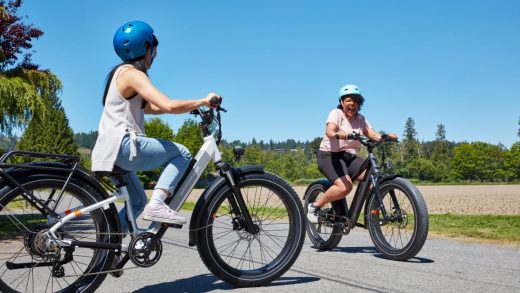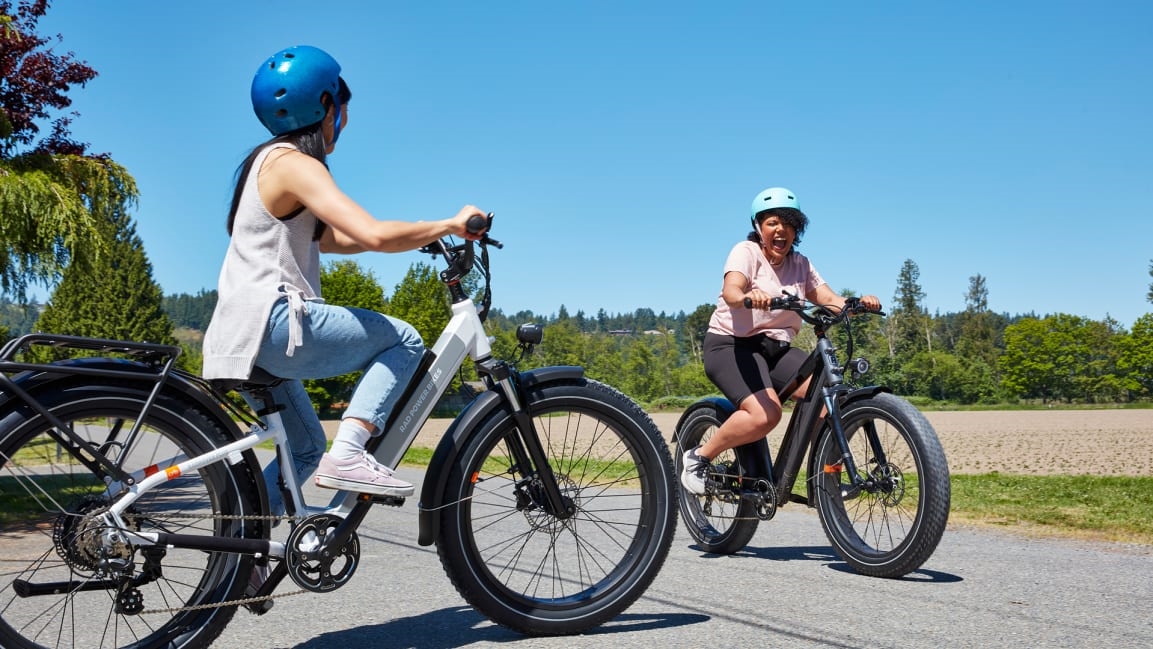Rad’s new e-bike is an update to its oldest model—and a preview of its future
In 2015, an electric bike entrepreneur named Mike Radenbaugh—who’d begun assembling bespoke e-bikes in small quantities as a high school student—teamed up with his friend Ty Collins to launch an Indiegogo campaign for a fat-tire e-bike called the RadRover.
According to Radenbaugh, his customers had been “all asking for the same sort of stuff. They were asking for bigger and bigger tires, bigger seats, for the handlebars to be higher up on the bike, more power, more range. People weren’t asking for a lighter e-bike. And so that’s when the RadRover was born.”
Radenbaugh and Collins crushed their crowdfunding goal, which got their company, Rad Power Bikes, started on a trajectory that made it North America’s largest e-bike brand, according to its own data. And then COVID-19 happened. But rather than Rad’s momentum stalling, it went into hyperdrive—along with the rest of the bicycle industry—as millions of people took up pedaling as a healthy alternative to being trapped inside their homes.
To date, Rad Power Bikes has sold more than 350,000 e-bikes—direct to consumers over the internet rather than through bike shops. Its lineup has grown to include models optimized for commuting, hauling stuff, and other scenarios. The versatile, adventuresome RadRover has remained its flagship—and North America’s best-selling e-bike, the company says.
Now Rad is introducing a new version, the RadRover 6 Plus. The “6” indicates that it’s the sixth generation of the model. The “Plus” isn’t there to distinguish it from a plain old RadRover 6—there isn’t one—but rather to underline that it’s a step up from any previous version
Compared to many of its competitors—both e-bike-centric upstarts and bicycle-industry behemoths—Rad Power Bikes takes on more of the responsibility of designing its own models rather than relying on stock ingredients provided by other manufacturers. That’s not to say it does everything itself: The RadRover 6 Plus’s gear system is from component kingpin Shimano, and Rad chose not to answer my questions about who supplies the motor, which is custom-tuned for the bike. But the new RadRover is full of touches unique to Rad, including some that could become future staples of the whole Rad line.
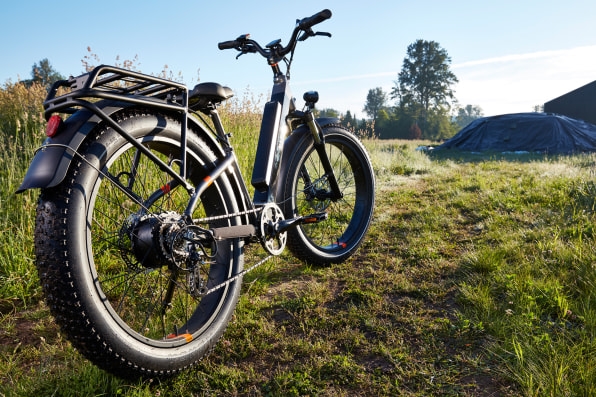
Higher price, better parts
In an industry where plenty of models go for $3,000, $4,000, and way, way up, the RadRover 6 Plus’s $1,999 price tag isn’t stratospheric. But it does come in at the top of Rad’s line and is $300 more than the RadRover 5. The extra investment gets you some pretty obvious benefits. For instance, it’s the first Rad model to sport hydraulic brakes—a feature whose presence is evidence that a bike manufacturer isn’t aggressively controlling costs to hit a price point.
Past Rad bikes have had batteries mounted to their frames’ exterior, which isn’t exactly streamlined or elegant. The RadRover 6 Plus introduces what Rad calls a “semi-integrated” battery, which sits in an indentation on the down tube and has a handle-like grip. Though not entirely concealed as on most pricier e-bikes, it’s way slicker than Rad’s old approach—more a fundamental part of the design and less of an improvisation.
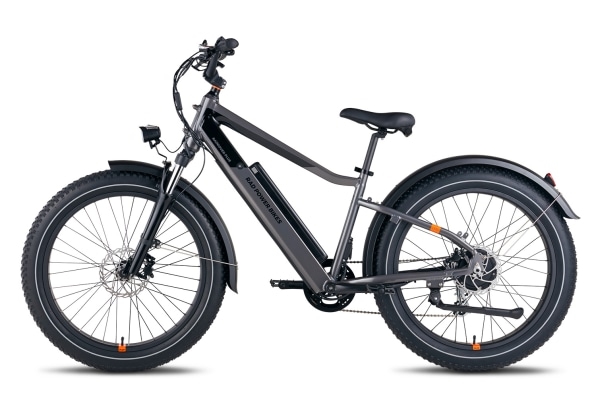
[Photo: courtesy of Rad Power Bikes]
“A lot of bike companies have chosen to make a battery fully integrated into the frame,” explains Redwood Stephens, Rad’s chief product officer. “We have chosen to say, ‘hey, this is an e-bike. And we’re going to design this battery from the ground up so that it’s easy for people to pop in and out if they want to bring it inside and charge it.’” (Convenient battery removal is a critical feature for owners who can’t store their bike near a power outlet.)
Like earlier Rad bikes, the RadRover 6 Plus features a control system with buttons on the left handlebar for tasks such as adjusting the level of electrical assistance and a large LCD screen centered on the handlebars. Now the left-hand controls have a smaller display of their own to put some relevant information literally at your fingertips. The company didn’t just get this system bundled with a third-party motor, as many e-bike makers do: It was “designed from the ground up by Rad’s designers and engineers,” says Stephens.
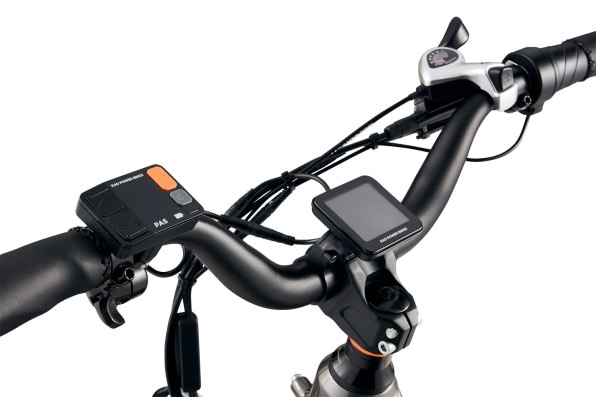
[Photo: courtesy of Rad Power Bikes]
One long-time practice that Rad is sticking with is offering the RadRover 6 Plus in a single frame size, which helps achieve economies of scale. At the same time, Radenbaugh says, “we’ve always seen our customers adopt the bikes as a household.” With that in mind, the company redesigned the new e-bike to more comfortably fit shorter riders than the previous model. Like the RadRover 5, it also comes in two variants: One with a conventional top tube, and a Step-Thru version that eliminates the top tube, allowing riders to get on and off the bike without swinging their leg around like an acrobat.
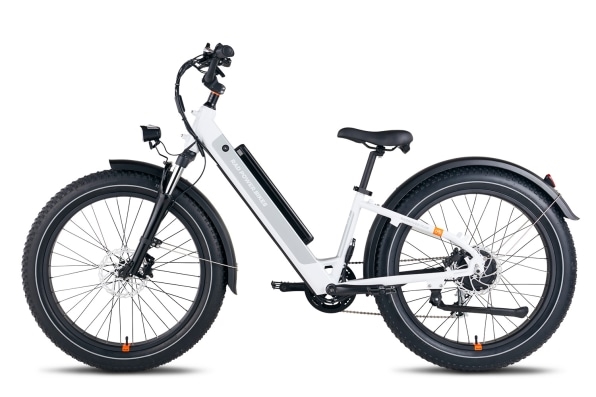
[Photo: courtesy of Rad Power Bikes]
Off road—or on
As with RadRovers dating back to the 2015 original, the RadRover 6 Plus is a beefy Sport Utility Vehicle of an e-bike. It sports jumbo-sized knobby tires and front suspension—the sort of features you want for riding on dirt, gravel, grass, and other surfaces beyond nice, smooth pavement. But just as many SUV owners lean into the “utility” rather than “sport” in everyday use, “a lot of people do use [the RadRover] for city commuting, and they just like the big tires,” says Stephens. “They don’t get caught in ruts or thrown off off course very easily.”

I got to take a RadRover 6 Plus for a jaunt on a 3.75-mile loop through San Francisco’s Presidio, where the roads are in good shape and opportunities to abandon them for more challenging terrain are limited. Even if the trip wasn’t a stress test for the RadRover, it was a blast. My own e-bike, from venerable Dutch bicycle manufacturer Gazelle, uses a motor mounted to the pedals and pretty much rides like a bicycle—albeit one that can provide varying degrees of assistance when I’m going uphill or am in a hurry. Rad’s bikes, by contrast, mount the motor to the rear wheel, where it’s not tied so directly to pedal power. They also give you a throttle that can propel the bike entirely on electric power, like a newfangled moped.
Between shifting the RadRover’s gears, adjusting the level of assistance, and calling on the throttle, I was able to cruise around with as much or as little exertion as I chose, even when I encountered hills. (As with all e-bikes, this one’s weight—an imposing 73 pounds—isn’t much of a factor as long as you don’t need to lift it.) I’m not saying that I preferred it to my Gazelle, which I ride in part to get exercise. But I can see why people who aren’t into the workout aspect of biking would be attracted to Rad’s less traditionalist approach to electrification.
The e-bike boom yet to come
Judging from my ride, the RadRover 6 Plus certainly seems up to the job of continuing Rad Power Bikes’ streak of success. But as long as I was chatting with CEO Radenbaugh, I asked him about a higher-level matter. Yes, there has been a surge of interest in biking—electrified and otherwise—during the global health crisis. More and more people have discovered that e-bikes are a fun, efficient mode of transportation that can even replace a car. But once the world gets back to some semblance of normalcy, will e-bikes continue their rise? Or is the current boom unsustainable?
Like many a brand born online, Rad sees traditional retail as its next frontier.
Radenbaugh pushes back at the notion that Rad’s success in 2020 and 2021 has been primarily an artifact of pandemic times, noting that the company was growing by triple digits every year even before COVID-19 entered the picture. It still struggles to keep up with demand—”we can’t stay in stock of anything,” he says—but has been upping its logistics game. (It recently chartered its own cargo ship to slash 54 days off the transit time for incoming parts.)
Along with just getting better at mass production of e-bikes, another challenge for Rad is expanding beyond its current online-savvy customer base. The company has grown as much as it has because so many people are willing to buy an e-bike over the internet—sometimes without having seen it in person—and perform final assembly such as attaching the front wheel, handlebars, and pedals themselves. Word of mouth has proven its most powerful marketing tool. But like many a brand that was born online, it sees traditional retail not as something to transcend but rather its next frontier.
Rad already has showroom/service centers in its hometown of Seattle and San Diego; along with Vancouver, British Columbia and Utrecht, the Netherlands. It’s also deployed vans that deliver bikes to prospective owners for test rides and offer mobile repairs, and has extended its service footprint through relationships with local bike shops and a company called Velofix. Now, after announcing a $150 million funding round in February, it has the wherewithal to build out a much more ambitious physical presence.
“If we really want e-bikes to be prolific, then we need to make it look more like Taiwan, maybe, where you’ve got a scooter repair shop on every corner,” muses Radenbaugh. “That’s the vision we have and what we’re going to go build—hundreds going on thousands of physical locations to complement the e-commerce experience.”
What Rad wants to do is convince vast numbers of people—particularly in the car-addicted U.S.—to think about two-wheeled transportation in a new way. Along with the e-bike industry as a whole, it’s off to a rousing start. But if it gets where it’s trying to go, it would make the pandemic e-bike boom look like a blip.
(36)

